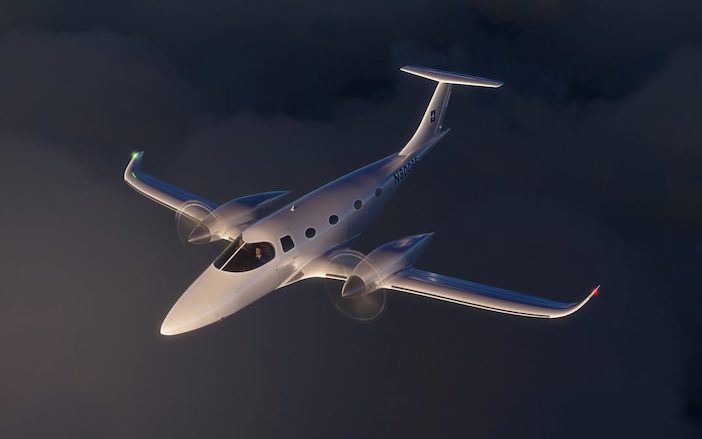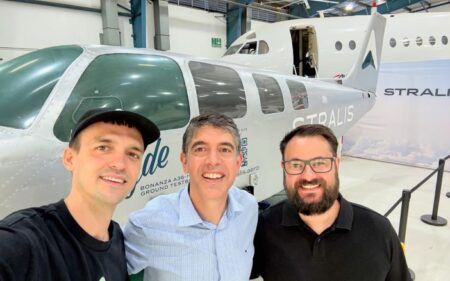In a busy week for electric aircraft development, Bye Aerospace has revealed the design for an eight-seat all-electric aircraft, while Ampaire’s second hybrid-electric test aircraft began its journey to the UK to make airline flight demonstrations as part of a research program.
Denver, Colorado-based Bye Aerospace is currently obtaining FAR Part 23 certification for its other all-electric aircraft, the eFlyer 2 flight trainer, and the four-seat eFlyer 4 for air taxi, cargo, and advanced training uses.
The new addition to Bye’s family of aircraft, the eFlyer 800 twin turbo-prop will have a 370mph (600km/h) cruise speed, 35,00ft ceiling and 575 mile (925km)range, said the company.
Safety features will include two wing-mounted electric motors, each with dual redundant motor windings, quad-redundant battery packs and a full airplane parachute. Additional “potential features” include emergency auto-landing system, intelligent algorithm ensuring envelope protection, terrain avoidance and routing for emergency auto-land, and also an option for supplemental power solar cells and in-wheel electric taxi.
Bye says that the eFlyer 800 will have one-fifth the operating costs of traditional twin turboprops and is similarly to the eFlyer4 is targeting the air-taxi, air-cargo, regional and charter aircraft markets with the airplane.
George E. Bye,CEO of Bye Aerospace said, “The eFlyer 800 is the first all-electric propulsion technology airplane that achieves twin-turboprop performance and safety with no CO2 and extremely low operating costs.”
“This type of remarkable economy and performance is made possible by the electric propulsion system and advanced battery cell technology that results in significantly higher energy densities.”
Bye Aerospace was working with Siemens on the electric powertrain for its aircraft, but since last November has been partnering with Safran. The French aerospace company is supplying its ENGINeUS motors for use on the eFlyer 2 and 4 and will work with Bye on the powertrain for the eFlyer 8.
“Safran product lines with the ENGINeUS motors, rated from 50kW to 500kW/1MW and GENeUSGRID systems, perfectly fit with the Bye Aerospace portfolio of e-aircraft,” said Hervé Blanc, Executive Vice President and General Manager Power with Safran Electrical & Power.
Ampaire’s Eel moves to the UK
Meanwhile, California-based hybrid-electric aircraft developer Ampaire announced its second Eel test aircraft was ready to be shipped to the south west of the UK to participate in a demonstration program trialling hybrid-electric regional aircraft.
Ampaire’s Electric Eel is a six-seat Cessna 337 twin-engine aircraft modified with a hybrid-electric propulsion system – an electric motor in the nose and traditional combustion engine in the rear.
This second test aircraft, nicknamed “Hawai‘i Bird” has previously made the company’s longest flight during testing, a 341 mile trip between Camarillo Airport north of Los Angeles and Hayward Executive Airport in California.
On the Road Again
Our second testbed aircraft, N337EE, is ready to ship to the UK for airline flight demonstrations. pic.twitter.com/9OX3YY5RtT— Ampaire (@AmpaireInc) April 16, 2021
The Eel is part of a UK Government-funded program called 2ZERO, which aims to demonstrate the use of hybrid-electric aircraft on regional routes. It will operate on a route between Exeter Airport in Devon and Cornwall AIrport in Newquay.
The two-year 2ZERO project is scheduled to finish in December 2022.





